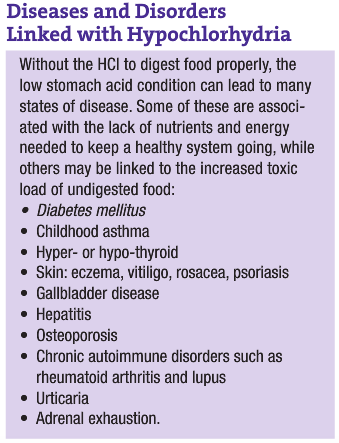Detecting Hypochlorhydria
Dicken Weatherby, ND
 Hypochlorhydria is a condition of decreased secretions of hydrochloric acid (HCl) and pepsin from the parietal cells in the stomach. Generally associated with aging, it can affect anyone at any age. In my opinion, lack of stomach acid is a pervasive issue in our population, and if diagnosed and treated effectively, many disease processes will be reversed and overall symptoms will improve dramatically. Hypochlorhydria is usually caused not by one thing, but by a series of the following:
Hypochlorhydria is a condition of decreased secretions of hydrochloric acid (HCl) and pepsin from the parietal cells in the stomach. Generally associated with aging, it can affect anyone at any age. In my opinion, lack of stomach acid is a pervasive issue in our population, and if diagnosed and treated effectively, many disease processes will be reversed and overall symptoms will improve dramatically. Hypochlorhydria is usually caused not by one thing, but by a series of the following:
- Aging It is well known that functional production of HCl decreases as we age.
- Stress One of the most important factors that shuts down HCl production is stress, marked by increased cortisol and decreased DHEA levels. The body needs to be in a parasympathetic mode for the optimal secretion of gastric juices.
- Chronic overeating Another common inhibitor of HCl production is chronic overeating, especially refined carbohydrates. Chronic overeating can “exhaust” the stomach, which has to concentrate the hydrogen ion four million times more than in arterial blood.
- Zinc and thiamine deficiency Zinc and thiamine are nutrients required for the production of HCl.
- Drugs Antacid drugs such as cimetidine, omeprazole, ranitidine and famotidine, as well as oral contraceptives.
- Lack of sufficient protein in the diet Protein is a strong stimulator for HCl secretion and release.
- Low estrogen levels associated primarily with menopause.
- Other causes Decreased production of HCl also can be attributed to coffee, alcohol and marijuana use; chronic overeating; autoimmune diseases (anti-parietal cell antibody); hypothyroidism; and excess carbohydrates in the diet.
What Happens When we Have Low HCl in the Stomach?
Hypochlorhydria occurs when the pH of the stomach falls below 3.5. Hypochlorhydria is associated with a number of problems, including:
- Improper digestion especially of proteins, which can putrefy in the digestive tract and cause gas and bloating
- Pancreatic insufficiency
- Reduced absorption of all nutrients
- B12 deficiency and pernicious anemia
- Mineral deficiencies (especially calcium and iron)
- Increased risk of infection
- Increased bacterial overgrowth in the digestive tract (dysbiosis)
- Ulcer formation in the stomach ( pylori)
- Autoimmune diseases (hypochlorhydria can lead to intestinal hyperpermeability).
Signs and Symptoms
The effects of low stomach acid can be insidious and progressive. Look for bloating, belching, burning and flatulence after a meal. Patients also might report feeling uncomfortably full after a regular-size meal. Indigestion, diarrhea and constipation can also be telling. Look for cracked, peeling or weak fingernails. Other less common symptoms of hypochlorhydria include rectal itching, undigested food in the stool, post-adolescent acne and nausea after taking supplements.
Using the Gastric String Test to Assess Stomach pH
To check a patient’s stomach pH for evidence of hypochlorhydria, consider the gastric string test. The gastric string test is a very safe and effective method of assessing stomach pH and can be performed quickly in-office. The test itself is 70cm of a highly absorbent cotton string coiled inside a weighted gelatin capsule. The capsule is swallowed by the patient and retrieved from the stomach after 10 minutes. The string is rubbed with a pH stick and the color is then compared to a pH chart provided with each capsule. The directions are easy:
- Have the patient eat a protein-rich meal two hours before the test (for an ambient pH, have the patient fast for 8-10 hours).
- Get the patient to swallow a little water to lubricate the throat.
- The patient swallows the capsule with a little water while the free end of the string is held firmly outside the mouth.
- After the capsule has been swallowed, have the patient lie on his or her left side or back for 10 minutes.
- After 10 minutes, get the patient to sit up and, with chin raised, swiftly remove the string.
- Lay the string on paper, and while string is still moist, touch the pH stick to the string starting at the distal end.
- Compare the resultant colors with the pH chart that comes with the test.
- Discoloration of any segment of the string represents acid pooling. Note: Do not expect the whole string to be a consistent color.
Results
Any result of pH 3 or lower indicates that the stomach is able to secrete acid normally. If the stomach pH is above 3, suspect hypochlorhydria. To confirm this, you may want to follow up with a bicarbonate challenge to assess the stomach’s ability to secrete stomach acid. (See my book, In-Office Lab Testing, for more information.)
With this simple, easy and inexpensive gastro test, you can identify hypochlorhydria and get patients’ digestion on the road to wellness. I highly recommend it.
 Dicken Weatherby, ND is based in southern Oregon. A graduate of NCNM, Dicken is co-author of the bestselling book Blood Chemistry and CBC Analysis-Clinical Laboratory Testing from a Functional Perspective. He has self-published seven other books in the field of alternative medical diagnosis, has created numerous information products, and runs a number of successful Web sites (www.BloodChemistryAnalysis.com, www.Health-E-Marketing.com and www.StrawBale.com). He is involved in research, writing and consulting, and teaches functional diagnosis seminars in both the U.S. and his native country, the U.K.
Dicken Weatherby, ND is based in southern Oregon. A graduate of NCNM, Dicken is co-author of the bestselling book Blood Chemistry and CBC Analysis-Clinical Laboratory Testing from a Functional Perspective. He has self-published seven other books in the field of alternative medical diagnosis, has created numerous information products, and runs a number of successful Web sites (www.BloodChemistryAnalysis.com, www.Health-E-Marketing.com and www.StrawBale.com). He is involved in research, writing and consulting, and teaches functional diagnosis seminars in both the U.S. and his native country, the U.K.
BOXOUT









